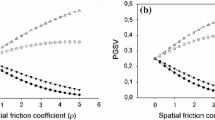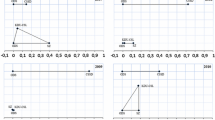Abstract
In this study, we present a generalization of spatial power indexes able to overcome their main limitations, namely (i) the excessive concentration of power measures; (ii) the too high sensitivity to players’ location in the ideological space. Voters’ propensity to support an issue is modeled via a random utility function with two additive terms: the deterministic term accounts for voters’ preference-driven/predictable behavior; the random one is a catch-all term that accounts for all the idiosyncratic/unpredictable factors. The relative strength of the two terms gives rise to a continuum of cases ranging from the Shapley value, where all aggregation patterns are equally probable, to a standard spatial value, like the Owen–Shapley index, where instead the conditional order is fully deterministic. As an illustrative application, we analyze the distribution of power in the Council of Ministers under three different scenarios: (i) EU15 Pre-Nice; (ii) EU27 Nice Treaty; (iii) EU27 Lisbon Treaty.
Similar content being viewed by others
References
Baldwin RE, Widgrén M (2004) Winners and losers under various dual majority rules for the EU Council of Ministers. In: Widgrén M Reasoned choices—essays in honor of academy Professor Hannu Nurmi on the occasion of his 60th birthday. The Finnish Political Science Association, Helsinki
Banzhaf JF (1965) Weighted voting doesn’t work: A mathematical analysis. Rutgers Law Rev 19: 317–343
Barr J, Passarelli F (2009) Who has the power in the EU?. Math Soc Sci 57: 339–366
Ben-Akiva ME, SR Lerman (1985) Discrete choice analysis: theory and application to travel demand. MIT, Cambridge
Braham M, Holler MJ (2005) The impossibility of a preference-based power index. J Theor Polit 17: 137–157
Dubey P, Neyman A, Weber RJ (1981) Value theory without efficiency. Math Oper Res 6: 122–128
Einy E, Haimanko O (2011) Characterization of the Shapley–Shubik power index without the efficiency axiom. Games Econ Behav 73(2): 615–621
Felsenthal DS, M Machover (2001) The treaty of Nice and qualified majority voting. Soc Choice Welf 18(3): 431–464
Felsenthal DS, Machover M (2004) Analysis of QM rules in the draft constitution for Europe proposed by the European convention, 2003. Soc Choice Welf 23(1): 1–20
Garrett G, Tsebelis G (1999) More reasons to resist the temptation of power indices in the European Union. J Theor Polit 11(3): 331–338
Garrett G, Tsebelis G (1999) Why resist the temptation to apply power indices to the European Union?. J Theor Polit 11(3): 291–308
Garrett G, Tsebelis G (2001) Even more reasons to resist the temptation of power indices in the EU. J Theor Polit 13(1): 99
Humphreys M, Laver M (2010) Spatial models, cognitive metrics, and majority rule equilibria. Br J Polit Sci 40(01): 11–30
Laruelle A, Valenciano F (2008) Voting and collective decision-making. Cambridge University Press, Cambridge
McFadden D (1984) Econometric analysis of qualitative response models. In: Griliches Z, Intriligator MD (eds) Handbook of econometrics, Vol II. Elsevier, Amsterdam
Milyo J (2000) Logical deficiencies in spatial models: a constructive critique. Public Choice 105: 273–289
Monderer D, Samet D (2002) Variations on the Shapley value. In: Aumann RJ, Hart S (eds) Handbook of game theory Vol III. Elsevier Science, Amsterdam
Napel S, Widgrén M (2004) Power measurement as sensitivity analysis. A unified approach. J Theor Polit 16(4): 517–538
Napel S, Widgrén M (2005) The possibility of a preference-based power index. J Theor Polit 17(3): 377–387
Napel S, Widgrén M (2006) The inter-institutional distribution of power in EU codecision. Soc Choice Welf 27(1): 129–154
Napel S, Widgrén M (2008) Shapley–Shubik versus strategic power—live from the UN Security Council. In: Braham M, Steffen F (eds) Power freedom and voting—essays in honor of Manfred J Holler. Springer, Berlin, pp 99–118
Napel S, Widgrén M (2011) Strategic versus non-strategic voting power in the EU Council of Ministers: the consultation procedure. Soc Choice Welf 37(3): 511–541
Owen G (1971) Political games. Naval Res Logistics Q 18(3): 345–355
Owen G, Shapley LS (1989) Optimal location of candidates in ideological space. Int J Game Theory 18: 339–356
Passarelli F, Barr J (2007) Preferences, the agenda setter, and the distribution of power in the EU. Soc Choice Welf 28(1): 41–60
Penrose LS (1946) The elementary statistics of majority voting. J R Stat Soc 109(1): 53–57
Roth, AE (eds) (1988) The Shapley value. Cambridge University Press, Cambridge
Shapley LS (1953) A value for n-person games. In: Khun HW, Tucker AW (eds) Contributions to the theory of games, vol II. Princeton University Press, Princeton, pp 307–317
Shapley LS, Shubik M (1954) A method for evaluating the distribution of power in a committee system. Am Polit Sci Rev 48: 787–792
Shepard RN (1987) Toward a universal law of generalization for psychological science. Science 237(4820): 1317
Steunenberg B, Schmidtchen D, Koboldt C (1999) Strategic power in the European Union. J Theor Polit 11(3): 339–366
Straffin PD (1977) Homogeneity, independence, and power indices. Public Choice 30: 107–118
Walker J, Ben-Akiva M (2002) Generalized random utility model. Math Soc Sci 43(3): 303–343
Weber RJ (1988) Probabilistic values for games. In: Roth AE (eds) The Shapley value: essays in honor of Lloyd S. Shapley. Cambridge University Press, Cambridge, pp 101–119
Author information
Authors and Affiliations
Corresponding author
Rights and permissions
About this article
Cite this article
Benati, S., Vittucci Marzetti, G. Probabilistic spatial power indexes. Soc Choice Welf 40, 391–410 (2013). https://doi.org/10.1007/s00355-011-0608-4
Received:
Accepted:
Published:
Issue Date:
DOI: https://doi.org/10.1007/s00355-011-0608-4




